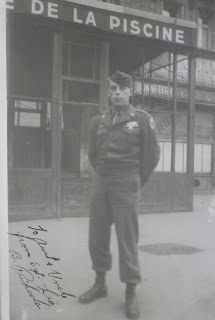Meeting Joe Esterreicher
http://home.earthlink.net/~jesterreicher/index.html
This blog is divided into 4 parts.
I will introduce you to Joe Esterreicher later in the blog.
Joe helped me find either directly or indirectly most of what you will read here.
And First the Names
Are we the nationality of the place of our birth?
Are we the nationality of our parents?
Are we the nationality of our ancestors?
...and if so how far back?
The surname Berger of my paternal lineage is most likely German. Although it is traced back to the late 1700s in Temesvar (Timis), Romania.
Note: Does that make us Romanian because of a border change giving land to Romania that was Hungarian land and populated by Hungarians.
The surname Szabo also of my paternal lineage is Hungarian because the letter Sz in the surname developed within the Hungarian language.
The surname Binder of my maternal lineage is found in Somogy Harsagy, Hungary from the late 1700s.
I know this information about the Binder lineage
thanks to Joe Esterreicher
• The surname Binder is not recognizable as Hungarian.
• Information on immigration documents state race as German
• Again, probably German but not traced back to Germany.
...not yet
Note: Does that make us German if we trace it there? Or does it make us Hungarian as parents were born in Hungary?
The Binders migrated from Somogy Harsagy, Hungary to what is now Herzegovac, Croatia where my mother was born.
Note:
• My mother told me that she was born in Herzegovina which is now a country (Bosnia/Herzegvovina) built from the breakup of Yugoslavia.
• The immigration record stated that Palesnik was the last place of residence. (transcription stated Poland! That will be another post.)
• As I scanned the maps of Croatia looking for Palesnik, I saw the city of Herzegovac a few miles to the north.
 |
| See the location in reference to Hercegovac |
• Her birth is registered in Palesnik, Croatia.
• Could she have meant Hersogovac?
• She did.
Note: Catherine Binder was born in Croatia. Does that make her Slavic having been born in Croatia?
Now, Some History
A study of European history, and the Danube Swabians might help in this discussion of my nationality:
 |
The Banat of the Danube Swabians
|
I learned that the Danube Swabians (Germans) populated the Banat areas and came into this area in three waves of migration. These waves of migration were due to three separate causes. (More on these three waves of migration in another blog.)
I quote from Joe Esterreicher's website here...
The people that
one can find family history on this web site are primarily ethnic Germans.
They came to this area of Croatia, starting about 1860. Most of these people
came to Croatia from Hungary or from an area in Europe that is now in the Czech
Republic. The Hungarian ethnic Germans can be traced back to the mid 1700 in
various church books. No filmed church records have been found for the Czech
Republic.
Joe quotes from the book:
Die Deutshen in Syrmien, Slavonien, Kroatien und Bosnien
By Dr. Valentin Oberkersch
Translated by Henry A. Fischer with his family permission 2006
The Regulation and Decree was issued by the Emperor on December 31
1858 and was addressed to Hungary, Croatia, Slavonia, the Serbian
Vojvodina, the Banat, and Transylvania with a renewed call for
agricultural settlement and development. Some of the regulations
included: homes for 50 families or more, all members of the community
must be of one nationality regardless of origin, and of one religion.
I quote from Wikipedia:
coming from a variety of areas (majority of them boarded boats in Ulm, Swabia, Germany and traveled to their new destinations down the Danube River) the were referred to as Swabians.
Note: Thus the name Danube Swabians
 |
| Joe Esterreicher |
Meeting Joe Esterreicher
• I met Joe Esterreicher in late 2008 visiting his website looking for the surname Pinter.
Note: Joe's research tells us that the letter P is sometimes substituted for B and the letter T is sometimes substituted for D and the reverse.
Hmmm? Can Pinter be Binder?
What can of worms would that open?
• Joe said the surname Pinter showed up on microfilms with the Somogy Harsagy information: 2065211 and 2065210 at FHL.
• The surname Binder appeared also... and frequently.
•As Joe is an avid genealogist, he located, pulled out, and put all the Binder entries from microfilms 2065211 and 2065210 into a word document for his website and sent a copy to me.
See:
Identifying My Nationality ??
• The Berger and Binder names appear to be German.
• The birth location of at least one of the Berger wives is Ersingen, Tübingen, Germany.
• Families with German surnames Schlichter, Bauman, Vagner and many others lived in the areas populated by Danube Swabian migration.
• Families with Binder surnames lived in areas that were populated by Danube Swabian migration.
• Immigration documents and census records state race as German for many family members
• The years that covered the sources of my family information coincides with the date of the three waves of migration.
• So much more research to be done on this assumption.
 |
Note the Temes (gold) and Somogy (red) areas.
Generations of my Binder family are now found in these areas and sourced
thanks to Joe Esterreicher! |
What nationality am I?
Write to me and share your thoughts on this topic.
See ya down the road,





























